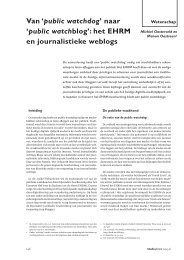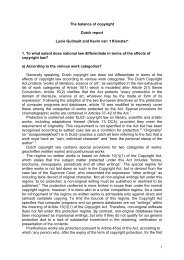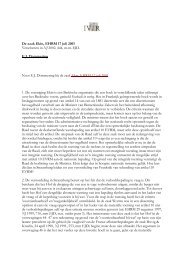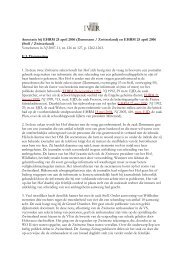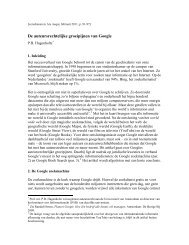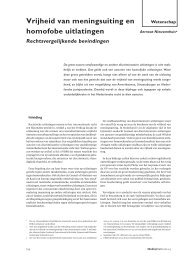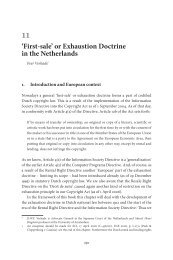unravelling the myth around open source licences - IViR
unravelling the myth around open source licences - IViR
unravelling the myth around open source licences - IViR
Create successful ePaper yourself
Turn your PDF publications into a flip-book with our unique Google optimized e-Paper software.
people who like it. Software sellers want to divide <strong>the</strong> users and conquer <strong>the</strong>m, making each<br />
user agree not to share with o<strong>the</strong>rs. I refuse to break solidarity with o<strong>the</strong>r users in this way.<br />
(…) Copying all or parts of a program is as natural to a programmer as breathing, and as<br />
productive. It ought to be as free. (…) GNU is not in <strong>the</strong> public domain. Everyone will be<br />
permitted to modify and redistribute GNU, but no distributor will be allowed to restrict its<br />
fur<strong>the</strong>r redistribution. That is to say, proprietary modifications will not be allowed. I want to<br />
make sure that all versions of GNU remain free.’ 23<br />
He calls this form of software ‘free software’. Free Software is, according to Richard Stallman,<br />
“free as in ‘free speech’, not as in ‘free beer’”. 24 The Dutch translation of this term would be ‘vrije<br />
software’. With this choice of words he wants to emphasise <strong>the</strong> freedom given to <strong>the</strong> software users.<br />
In 1985, he established <strong>the</strong> Free Software Foundation (FSF), creating an institutional framework for<br />
<strong>the</strong> development of free software, and in particular of <strong>the</strong> GNU project.<br />
One of <strong>the</strong> first attempts of Stallman to lay down <strong>the</strong>se principles in a licence resulted in <strong>the</strong><br />
development of <strong>the</strong> GNU Emacs Licence. Stallman used this licence for <strong>the</strong> distribution of Emacs, a<br />
text editing program which he had created. The GNU Emacs Licence allowed users to redistribute<br />
and change Emacs under <strong>the</strong> condition that modifications would have to be published and brought<br />
out under <strong>the</strong> same licence. 25 Stallman distributed Emacs by sending a copy on tape at a price of 150<br />
dollars.<br />
In February 1989, Stallman produced <strong>the</strong> first version of <strong>the</strong> GPL. 26 This licence is in many<br />
ways similar to <strong>the</strong> GNU Emacs License, with <strong>the</strong> exception that a user who has been changing<br />
software under <strong>the</strong> GPL is not obliged to publish any changes he has made. Because of its ‘Big<br />
Bro<strong>the</strong>r’ nature Stallman decided not to include this obligation in <strong>the</strong> GPL. 27<br />
In June 1991, a second and more recent version of <strong>the</strong> GPL was published. 28 While <strong>the</strong> text of<br />
this later version of <strong>the</strong> GPL has been changed, its spirit has remained <strong>the</strong> same. The ‘share and<br />
share alike’ or ‘copyleft’ aspect of <strong>the</strong> GPL is its most important functional characteristic. According<br />
to this stipulation, modifications to <strong>the</strong> code are allowed by must be distributed under <strong>the</strong> GPL. The<br />
GPL can be considered a success, for it is used in <strong>the</strong> majority of <strong>open</strong> software projects worldwide.<br />
Fur<strong>the</strong>rmore, <strong>the</strong> FSF has become an important player in <strong>the</strong> software market. Since <strong>the</strong><br />
establishment of <strong>the</strong> FSF, <strong>the</strong> Free Software Foundation Europe and several national Free Software<br />
Foundations have come into being. 29<br />
However successful <strong>the</strong> GPL has been over <strong>the</strong> years, <strong>the</strong> transformation and globalisation of<br />
<strong>the</strong> <strong>open</strong> <strong>source</strong> software industry has rendered a revision of <strong>the</strong> text of <strong>the</strong> licence necessary. In a<br />
recent document exposing <strong>the</strong> philosophy of <strong>the</strong> Free Software Foundation behind <strong>the</strong> adoption of a<br />
third version of <strong>the</strong> GPL, Stallman and Moglen explain:<br />
‘The Free Software Foundation has never been reluctant to point out that its goals are<br />
primarily social and political, not technical or economic. The Foundation believes that free<br />
software---that is, software that can be freely studied, copied, modified, reused, redistributed<br />
and shared by its users---is <strong>the</strong> only ethically satisfactory form of software development, as free<br />
and <strong>open</strong> scientific research is <strong>the</strong> only ethically satisfactory context for <strong>the</strong> conduct of<br />
23 Also see Richard Stallman, ‘Initial Announcement’ at http://www.gnu.org/gnu/initialannouncement.html.<br />
24 See Richard Stallman, ‘The Free Software Definition’, at http://www.gnu.org/philosophy/freesw.html.<br />
25 Williams 2002, p. 124 and Levy 2001, p. 416.<br />
26 GNU General Public License Version 1, at http://www.gnu.org/copyleft/copying-1.0 html.<br />
27 Williams 2002, p. 127.<br />
28 GNU General Public License Version 2, June 1991 at http://www.gnu.org/licenses/gpl.txt.<br />
29 See http://www.fsfeurope.org/.<br />
9


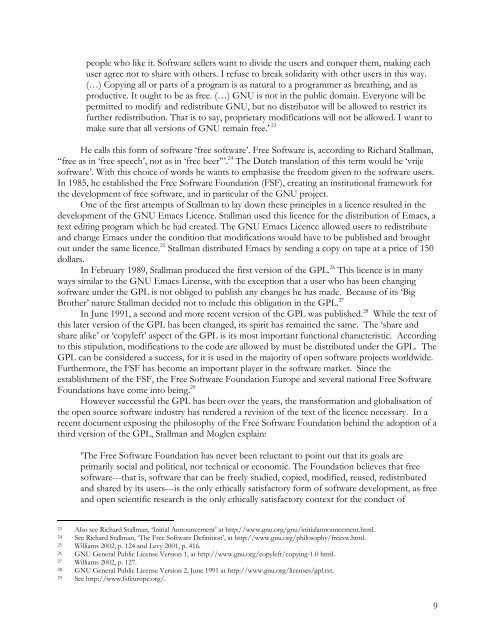
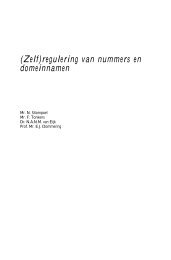
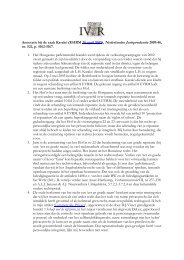

![Legal Opinion of Professor Egbert Dommering [1] concerning ... - IViR](https://img.yumpu.com/23603085/1/184x260/legal-opinion-of-professor-egbert-dommering-1-concerning-ivir.jpg?quality=85)
